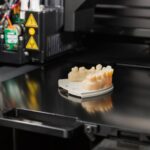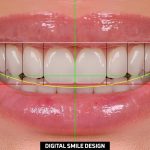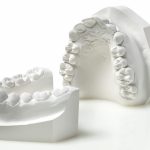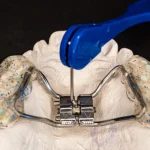
In daily clinical dental practice it is very common to observe issues that extend to the subgingival level. The management of these issues is complex and requires measures to enable proper tooth restoration.
A carious lesion can extend apically even below the gingival margin, making it virtually untreatable since it cannot be isolated correctly.
Another typical example is a dental fracture in which the fracture line runs apically under the gingival margin, possibly extending to the bone level. Even in this case, rehabilitation without exposing the fracture margin would result in an unfavourable restoration prognosis and, in the long term, to inevitable failure. (1)
What is orthodontic extrusion and how does it work?
Orthodontic extrusion, in this context, represents a clinical procedure that can offer the patient unquestionable benefits. (1)
Extrusion is a translational movement of the tooth with a vector parallel to its long axis and with a coronal direction.
In a (slow) normal orthodontic extrusion, a light extrusive force is applied to the tooth which begins to move coronally. Due to the presence of the periodontal ligament, tooth movement brings with it the coronal migration of supporting tissues such as the periodontal ligament, gingival tissue and bone tissue. A slow orthodontic extrusion is in fact able to make all the supporting tissues migrate in a coronal direction. (1)
When heavier forces are used, however, we begin to talk about rapid extrusion. In this case, the migration of the supporting tissues is less marked since the movement of the tooth is faster than the physiological adaptation of the tissues. (1) It is as if the tooth were slipping out of the periodontal compartment.
Indications and contraindications of orthodontic extrusion
The indications for orthodontic extrusion are (1):
- Management of infraoccluded or impacted teeth
- Exposure of subgingival dental structures to facilitate rehabilitation
- Treatment of vertical/angular periodontal defects
- Modification of the anatomy of the gingival parabola and management of the interdental papilla levels
- Preparation of the implantation site (2,3)
Contraindications are:
- Vertical root fractures
- Ankylosis
- Severe internal or external root resorptions
- Untreated periodontitis
- Systemic pathologies that alter bone metabolism
When orthodontic extrusion has the aim of preparing the implant site and extraction of the tooth is therefore planned, some contraindications may be considered relative.
What are the advantages of orthodontic extrusion (1)?
It is an extremely conservative treatment which, unlike a clinical crown lengthening procedure, is in no way invasive to the supporting tissues. A clinical crown lengthening procedure, in fact, has the objective of exposing the carious lesion or the fracture line by repositioning the tissues apically and therefore removing bone tissue and relocating the soft tissues.
It is often impossible to limit the procedure to the affected tooth, hence, the adjacent teeth are also involved. With orthodontic extrusion, the carious lesion or fracture line is exposed by extruding the tooth, theoretically without moving the supporting tissues.
What are the disadvantages of orthodontic extrusion?
The major disadvantage is having to endure the application of an orthodontic device for a long time, with the consequent aesthetic discomfort and the difficulty in maintaining acceptable hygiene.
The treatment can last a long time; the extrusion time usually runs from four to six weeks, followed by the tissue stabilisation time. Not all patients are willing to endure such a long treatment.
It is also possible that temporary occlusal pre-contacts may be created during the procedure. It should also be considered that at the end of the extrusion treatment, small periodontal surgical interventions may be necessary to correct any residual discrepancies.
Main orthodontic extrusion techniques
Many orthodontic extrusion techniques are proposed in the literature.
There are different protocols, each with specific characteristics and objectives (4).
- Orthodontic extrusion with circumferential supracrestal fibrotomy and without intermediate stabilisation: this approach aims to extrude the tooth without modifying the periodontal tissues; the rationale behind it is to try to extrude the tooth without having the tension on the tissues created by the periodontal ligament.
For this reason, it is necessary to apply heavy forces and frequently perform supracrestal fibrotomies in order to eliminate the forces deriving from the connective tissue attachment as much as possible. The goal is to rapidly expose subgingival structures to facilitate restoration. - Orthodontic extrusion without supracrestal fibrotomy and without intermediate stabilisation: in this case, extrusion of the tooth and migration of the gingival tissues are sought but coronal migration of the bone tissue is not. The aim is essentially to extrude the tooth with the soft tissues, creating an elongated junctional epithelium.
It is a useful approach when you want to modify the gingival curve or you want to modify the pre-implant site. Heavy forces are used.
- Orthodontic extrusion without circumferential fibrotomy but with intermediate stabilisation: in this case the intermediate stabilisations ensure that the supracrestal connective fibres are reorganised along with the soft tissues and that coronal bone apposition can therefore occur.
In this case, light forces are preferable and active extrusion should be interrupted to allow the supporting tissues time to migrate coronally. This approach should be chosen when you want to manage infraocclusion or impaction of dental elements, when you want to treat periodontal defects, when you want to modify the periodontal architecture or when you want to manage a pre-implant site.
Orthodontic extrusion is a very effective strategy that, if managed correctly, can offer the dentist and therefore the patient a series of benefits that are difficult to achieve using more invasive periodontal surgery techniques.
References
- Bach, N., Baylard, J. F., & Voyer, R. (2004). Orthodontic extrusion: periodontal considerations and applications. Journal (Canadian Dental Association), 70(11), 775-780.
- Korayem, M., Flores-Mir, C., Nassar, U., & Olfert, K. (2008). Implant site development by orthodontic extrusion: a systematic review. The Angle Orthodontist, 78(4), 752-760.
- Amato, F., Mirabella, D., Macca, U., & Tarnow, D. P. (2012). Implant site development by orthodontic forced extraction: a preliminary study. International Journal of Oral & Maxillofacial Implants, 27(2).
- González-Martín, O., Solano-Hernandez, B., Torres, A., González-Martín, S., & Avila-Ortiz, G. (2020). Orthodontic Extrusion: Guidelines for Contemporary Clinical Practice. International Journal of Periodontics & Restorative Dentistry, 40(5).
Would you like more information about Zhermack Dental products and solutions?
Contact us




 Zhermack SpA has been one of the most important producers and international distributors of alginates, gypsums and silicone compounds for the dental sector for over 40 years. It has also developed solutions for the industrial and wellbeing sectors.
Zhermack SpA - Via Bovazecchino, 100 - 45021 Badia Polesine (RO), Italy.
Zhermack SpA has been one of the most important producers and international distributors of alginates, gypsums and silicone compounds for the dental sector for over 40 years. It has also developed solutions for the industrial and wellbeing sectors.
Zhermack SpA - Via Bovazecchino, 100 - 45021 Badia Polesine (RO), Italy.


